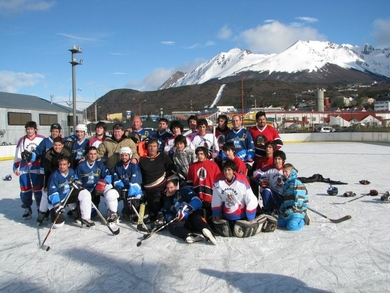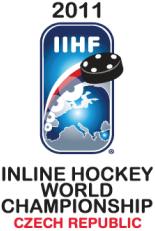PARDUBICE – The IIHF InLine Hockey World Championship is an important event for some countries, not only to develop inline hockey, but also to introduce ice hockey.
One such country is Argentina. The Argentine Ice Hockey and Inline Hockey Association has been an IIHF member since 1998 and inline hockey has been played the country since 1996. This South American nation has qualified for several Division I tournaments in inline hockey – including this year in Pardubice.
“Inline hockey was not a very popular sport in South America in the beginning, so we started to progress slowly and make the sport known,” says Belén Urbaneja, the General Secretary. “We have now participated in these tournaments and have organized several events in Buenos Aires with teams from Brazil, Columbia, Ecuador and Chile.”
Similar to Brazil the country has begun developing ice hockey through inline hockey. The association lists 500 players who play one of the sports, or even both.
“Through inline hockey we are developing ice hockey, so it’s the other way around than in many other countries because it’s very difficult to have rinks with artificial ice in South America due to the weather and the cost.”
Urbaneja started playing inline hockey herself as an adult, and through the sport she also met her husband Roberto Villagra, a former ice hockey and inline hockey player, and the national team coach for the last few years.
“There are very few, but passionate people working on hockey and I’m very passionate about it too, that’s how I started to get involved,” Urbaneja looks back.
Hockey still remains an exotic sport in the country. Telling somebody in Buenos Aires you play inline hockey or even ice hockey might cause surprise.
“There’s no broadcasting in TV networks and we don’t get images from the (ice hockey) World Championship or the Stanley Cup. Football is of course the most popular sport, but there are also other sports than football. So it’s very hard work we need to do to make our sports more popular,” Urbaneja explains the situation.
“Another problem is that we don’t have equipment distributors in Argentina, so it’s very expensive because we have to bring it from the U.S. or somewhere else. We have asked some bigger countries and hope to get used equipment we would be happy to use. There are some conversations we need to start.”
Money is surely a problem. Because of limited funding the players have to pay for the trip to Europe themselves. This limits the circle of candidates.
“What’s very important for us is to get the support from the national sport secretary and the national Olympic committee to get funds for travelling to tournaments,” Urbaneja said.
Still, there are many people who want to get involved into the sport.
“Once I went to the USA to visit relatives and I was watching an NHL game and thought I want to play this game too,” remembers Facundo Vadra, the captain of the Argentine national inline hockey team.
“A few years later somebody opened an inline hockey rink in Buenos Aires and I started to play. There was no ice rink at that time, but a few years ago I also started to play ice hockey. Not so often, but I try to play.”
Right now the organization tries to bring kids to the rink for beginners’ events, with equipment they can borrow for the kids’ first steps on rollerblades or ice skates. But especially for ice hockey time is limited. There are only small rinks and they are mostly open for public skating with few hours available for hockey.
To develop advanced ice hockey players there’s also the idea of participating in events in Mexico, the only Latin American country that fulfils the minimum standards to participate in the IIHF World Championship program with its national ice hockey teams.
“We have a big project to build an ice rink in Buenos Aires and submitted the budget to the national Olympic committee,” Urbaneja said about plans to improve the situation for ice hockey in Argentina. “If we have a big ice arena we can do a lot and get the sport bigger.”
The good news came last year when the first international-size outdoor ice rink opened in the south of the country.
“The ice rink in Buenos Aires is very small, but last year a new rink of 60 x 30 metres opened in Ushuaia,” Vadra says. “Unfortunately it’s very far, but it’s really good to have a big rink there. I went to play there last year and in one month I’ll go there again to keep practising ice hockey.”
The city of 63,000 inhabitants in the Tierra del Fuego Province is commonly regarded as the southernmost city in the world and thus a perfect place to play outdoor hockey in the chilly months when it’s summer in the northern hemisphere.
The distance to the South Pole can be compared with the one of Belfast, Chelyabinsk, Edmonton or Vilnius to the North Pole.
The only problem is that the city is about 2,400 kilometres away from Buenos Aires and flight tickets are expensive. The hockey scene is geographically split between those two regions at each end of the country.
“In the south of the country where ice is something more natural we have lots of schools and athletes that are associated with us,” Urbaneja explains. “In our winters it can be -20°C there. Many people go there for skiing. But because the rink is outdoors we also have to deal with the wind, so it’s not always so easy to play. Sometimes we need to change schedules and be flexible because of the weather conditions. Athletes also practice of frozen lakes there.”
An ice hockey tournament had to be cancelled recently because of the volcanic eruption in Chile that also hit parts of Argentina. But the organizers hope to stage it soon, maybe even with teams from other countries such as Brazil, Columbia or Ecuador. Last autumn a tournament with teams from Argentina and one from Brazil was staged on the rink (see photo below).
Meanwhile Argentina focuses on its national inline hockey team these days. Although it was relegated last year in Karlstad, Sweden, it was invited some weeks ago to replace Japan, which had to withdraw its teams due to the natural disaster in the country.
“It’s really nice to be here again, although it was unfortunately due to the situation in Japan,” Vadra says.
This year the Argentines hope to make it better and the results show that the gap between other Division I countries has become smaller.
“We’re learning to play and to get more competitive. It’s for sure better than last year,” says Vadra. “We have improved our skating and passing, but we need to improve in shooting. It’s good to be here for a second straight year. It’s important to keep going with inline hockey and ice hockey in our country.”
After losses to Hungary (4-2) and last year’s Division I silver medallist Croatia (7-1) the Argentines will meet New Zealand, one of the qualifiers, on Tuesday afternoon. After that they will likely play for survival in the placement games unless a miracle happens against one of the top teams in the quarter-finals.
Due to Japan’s one-year break three out of the eight teams from Division I will be relegated this time. It will be hard work for those teams that won’t make the semi-finals.
MARTIN MERK
 An international-size outdoor ice rink opened in Ushuaia in 2010. Photo: AAHHL
An international-size outdoor ice rink opened in Ushuaia in 2010. Photo: AAHHL






